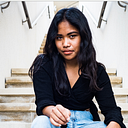VICE Arabia: The UAE Arts Scene in Transience (EN)
UAE-based creatives navigate the nuances of “home” in a country where non-nationals are eternally temporary.
Originally posted in Arabic on VICE Arabia.
How does one create a home and make art in the UAE, where transience and temporariness prevail? This question, amongst others, is one that Dubai-based American artist Christopher Benton tries to answer in his debut exhibition as curator, “Do You See Me How I See You?”.
Hosted in maisan15, a grassroots culinary and artistic space in Dubai, the exhibition collages together 16 artworks by 11 UAE-based artists. Reflective of the diasporas that dwell in the country, the exhibition features works of artists from countries like the Philippines, India, Palestine, Germany, the U.S., and the UAE.
The exhibition tackles the nuances of “home” in a country where non-nationals are eternally temporary. Independently-run and curated, the exhibition feels rare in a city where art experiences are often associated with commercial gallery spaces and large institutions. Encountering art in an intimate culinary space like maisan15, where customers can consume art while they consume their meal, adds greater depth to the landscape of the UAE’s young and ever-evolving arts and culture scene.
Emirati cultural entrepreneur and artist Rami Farook, founder of maisan15, is optimistic about the evolution of the UAE arts scene through the collaboration of artists that reside in the country. “The UAE independent arts scene is growing through different areas of art… they’re growing through collaboration, they’re growing through activation of public and semi-public spaces, like [maisan15].”
The artists in the show come from a community of UAE-based creatives who juggle full-time careers in other industries. In recognizing this, Benton shares, “all artists everywhere have to negotiate making money and making art but that paradox is even more relevant in the UAE where artists either need a visa from their parents, a spouse, or [have] a job. Being an artist here is not a government-recognized job title.”
Layan Attari, whose photographs of military-themed cakes caught the query of many in the show, highlights this reality as a full-time graphic designer. “The cultural ecosystem here does not provide the framework to make a living as an artist for most people,” she shares. The artists in the exhibition, then, have a “hybrid practice that pays for and feeds their art career”, as Benton puts it, while also navigating their identities as temporary people in the UAE. This is because the bureaucratic landscape of the UAE makes it difficult to call the place home, as permanent residence visas come rare and often with a hefty price.
However, the growing ecosystem of arts and cultural institutions of this young country make it a fertile breeding ground for contemporary works from migrant-identifying bodies. Although artists in the UAE have to balance livelihood and art-making like in other countries, Benton reflects that “it’s easier to make art in the UAE in some ways [because] there’s significant government support and funding for ambitious art projects.” Examples of such initiatives include the Jameel Art Center’s Youth Assembly and Salama Bint Hamdan Emerging Artist Fellowship (SEAF), cultivating the next generation of creators and curators.
Conversely, Farook also adds that the new wave of artists in the region find support within their community which enables them to pioneer cultural experiences outside mainstream insitutions. “Artists now are realizing that ‘No, I won’t accept [solely working with institutions], I’m gonna be independent, I’m gonna use my Instagram as my gallery, I’m gonna use my friend’s space as my museum, I’m gonna use my house as a studio’.”
This support, both from institutions and communities, is also bolstered by the safety felt in the UAE; the almost-50-year-old nation ranks as the third safest country in the world. Attari reflects that, “As a Palestinian, living in the UAE, to me, has felt relatively detached from conflicts in the surrounding region. For people that are able to live here, this provides a stable enough environment to develop a creative voice.”
In addition, with 90% of its population composed of people from over 200 nationalities, the cosmopolitan nature of the UAE allows for intercultural exchange and dialogue that ultimately impact artists’ creative process. Mohamed Khalid, whose five ceramic sculptures of soaps in the exhibition allude to the ceramic industry of Ras Al Khaimah, see the UAE as a place that “provided [him] with a multifaceted view of what it is to be a community with people from various parts of the world. As someone who speaks 5 languages… it was this exposure to different cultures that has allowed me to learn and communicate my experiences and hear about others’.”
The youth of the UAE’s artistic landscape also allows underrepresented identities to take up space and help weave the fabric of its growth. In an interview with Global Art Daily (GAD), a UAE-founded independent arts and culture publication, Filipino photographer and artist Augustine Paredes describes Dubai as a place where he’s been given space to be vulnerable as an artist. “That’s the direction Dubai is going in, in my opinion. Dubai is going to be more accepting, it’s going to be more open, I hope.”
The rarity of Filipino artists in Dubai gives him space to take up space. His two photographs in maisan15 are very poignant, evocative of the melancholy of making a home in a place that isn’t yours. “I’ve always made sure that I represent and I take up space as a Filipino artist here in Dubai,” he shares with GAD, “because there aren’t many [of] us.”
Benton’s conversation-stirring exhibit in maisan15 allows its audience to experience art in a new light. As the art pieces intertwine with the clinking of pots and the aroma of freshly baked bread, exhibitions like his create more access points into the art world for the general public in the UAE. As the country grows, so does its artist community, and the collection of UAE-based diasporic artists in Benton’s exhibition is an example of the UAE’s bright future.
